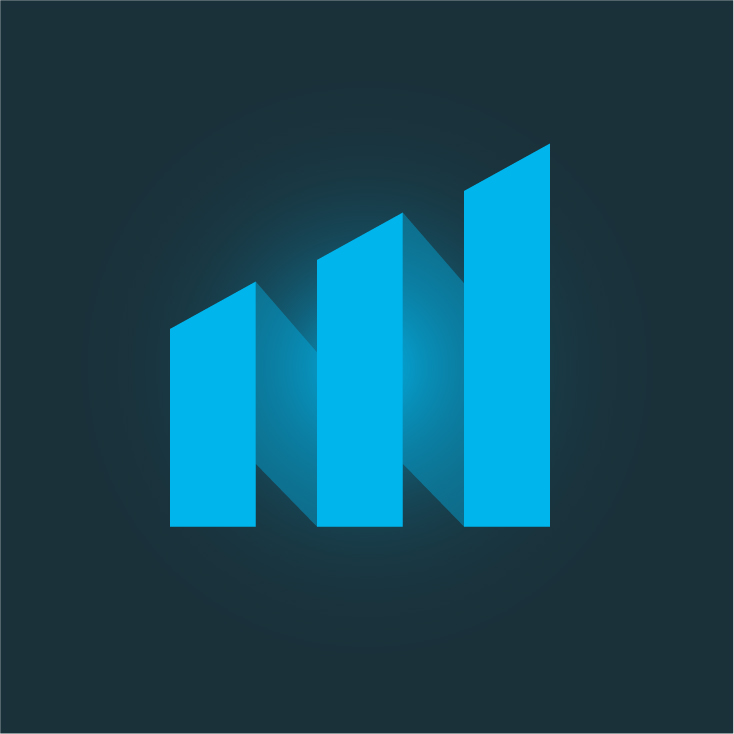1. Starting from storage, AO helps Arweave regain its momentum
Arweave mainnet was launched on November 18, 2018. In the past five years, it has undergone 13 major upgrades, and its business direction is permanent decentralized storage services. However, when we observe the changes in network data, we find that the above upgrades have not really formed a moat for Arweave. Observing Arweaves business data, we can see that:
After entering 2023, the growth rate of Arweaves storage business has slowed down significantly, and the increase in storage data has dropped sharply. The monthly network storage volume has hovered between 2-4 TiB. The lowest network storage volume was in June, with only 1.43 TiB. The total storage volume for the whole year of 2023 was 32.96 TiB. In comparison, the total storage volume of Filecoin network in 2023 exceeded 1.8 EiB (1 EiB = 1, 048, 576 TiB). It can be seen that in decentralized storage, Arweave cannot shake Filecoins dominant position at all, and business expansion is very difficult.
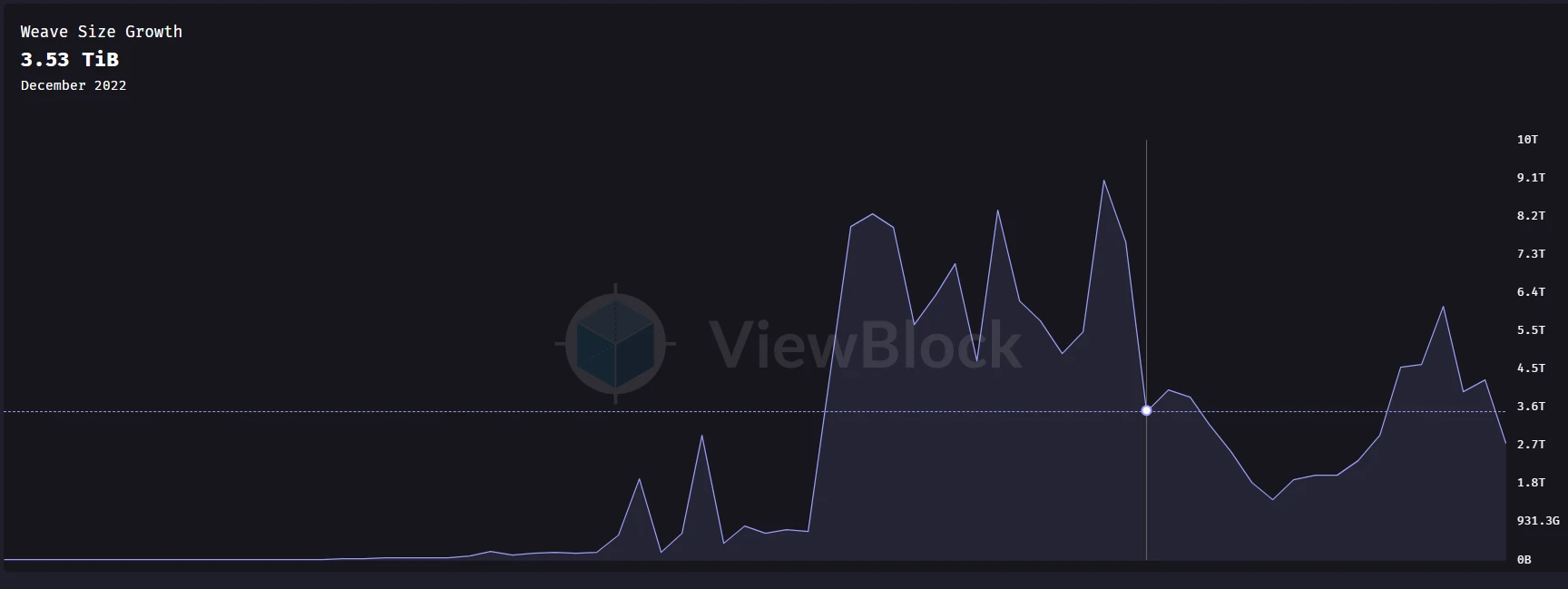
Not only is it difficult to break through the horizontal competition in similar businesses, the track that Arweave is in - decentralized storage, is a certain distance away from ordinary retail investors. Ordinary users do not have much motivation to use it, nor can they quickly perceive changes in fundamentals. In the new bull market, decentralized storage has more or less taken advantage of the AI/DePIN narrative, but it is just old wine in a new bottle and has not received much market attention.
This dilemma is also reflected in the price of the currency. Taking a one-year analysis period, before February 2024, the price of AR has been hovering around 6-10 dollars, significantly underperforming BTC, and has not risen with the mainnet upgrade and the start of the bull market, until the founder Sam announced on February 14 that Arweave officially launched AO.
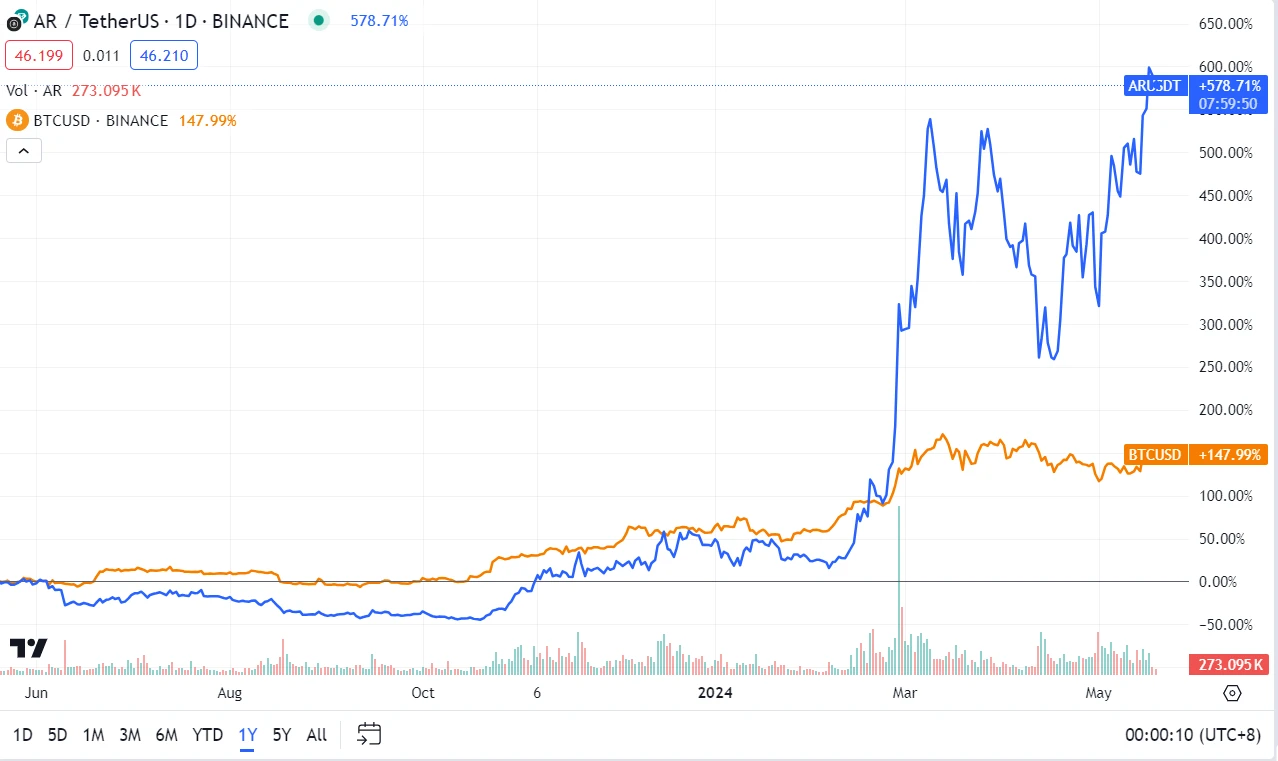
As a storage protocol, Arweave can only be seen as a hard drive. A hard drive alone cannot carry a larger narrative and usage scenario. For a long time, Arweave has hoped that other protocols will use its hard drive, but the results have been minimal. It is too far away from the infrastructure of ordinary users and lacks market attention. Therefore, Arweave created a CPU that is perfectly compatible with its own hard drive, AO, which also caused its coin price to rise rapidly from $8 to nearly $50. This article will mainly introduce the technical principles and related ecology of AO.
1.1 AO Technical Principles: How to achieve verifiable infinite computing?
AO is an Actor Oriented computer running on Arweave, designed as an environment that can host any number of parallel processes, which are coordinated through an open message passing layer.
The core features of AO can be summarized into two:
(1) Any number of processes can run in parallel, which means unlimited expansion of computing power;
(2) The computational results must be verifiable and reproducible, thereby achieving minimum trust.
Before introducing how AO implements the above functions, lets first understand the basic structure of AO. The AO system contains two basic units: process and message, and three basic units (which can also be regarded as three important roles): scheduling unit (SU), computing unit (CU) and messenger unit (MU).
Process: A computing unit in a network. The state of a process can be calculated by computing units, and a process can receive messages from users and other processes. In the specific definition, $P_i$ represents the $i ^{th}$ process. Define $P_i$ = ($Log_i, Init_i, Env_i$), where $Log_i$ is an ordered sequence of all messages of $Pi$, $Init_i$ is the initialization data of $P_i$, $Sched_i$ is the scheduler of $P_i$, $Env_i$ is the computing environment of $P_i$, and at a given time step, the state of $P_i$ is $S(P_i) = F(Log_i, Env_i)$, where F is a function defined by $Env_i$ that calculates the state based on the message log.
Message: Every interaction with a process in AO is represented as a message. The essence of a message is a data item that conforms to the ANS-104 standard. The unification of the message format is crucial. The entire AO environment is settled on Arweave’s decentralized data layer through unified messages.
Scheduling Unit: The scheduling unit is responsible for assigning atomically increasing slot numbers (similar to Ethereum nonce) to information sent to the process, that is, sorting the process messages. After allocation, the scheduler needs to ensure that the data is uploaded to Arweave so that it can be permanently accessed by others.
Computing unit: The computing unit is the node responsible for calculating the process status in the AO. The computing units form a computing market similar to the decentralized computing protocol (Akash). The computing units compete with each other to complete the service of calculating the process status. After the service is completed, the computing unit needs to return the calculation result and the status proof with a signature. If the user does not trust a single computing unit, he can further initiate requests to more computing units. The computing unit needs to make a certain pledge. If the wrong status is provided, its pledge will be fined.
Messenger Unit: The messenger unit is responsible for receiving incoming messages from clients, routing these messages to designated dispatch units, and then retrieving results from computation units.
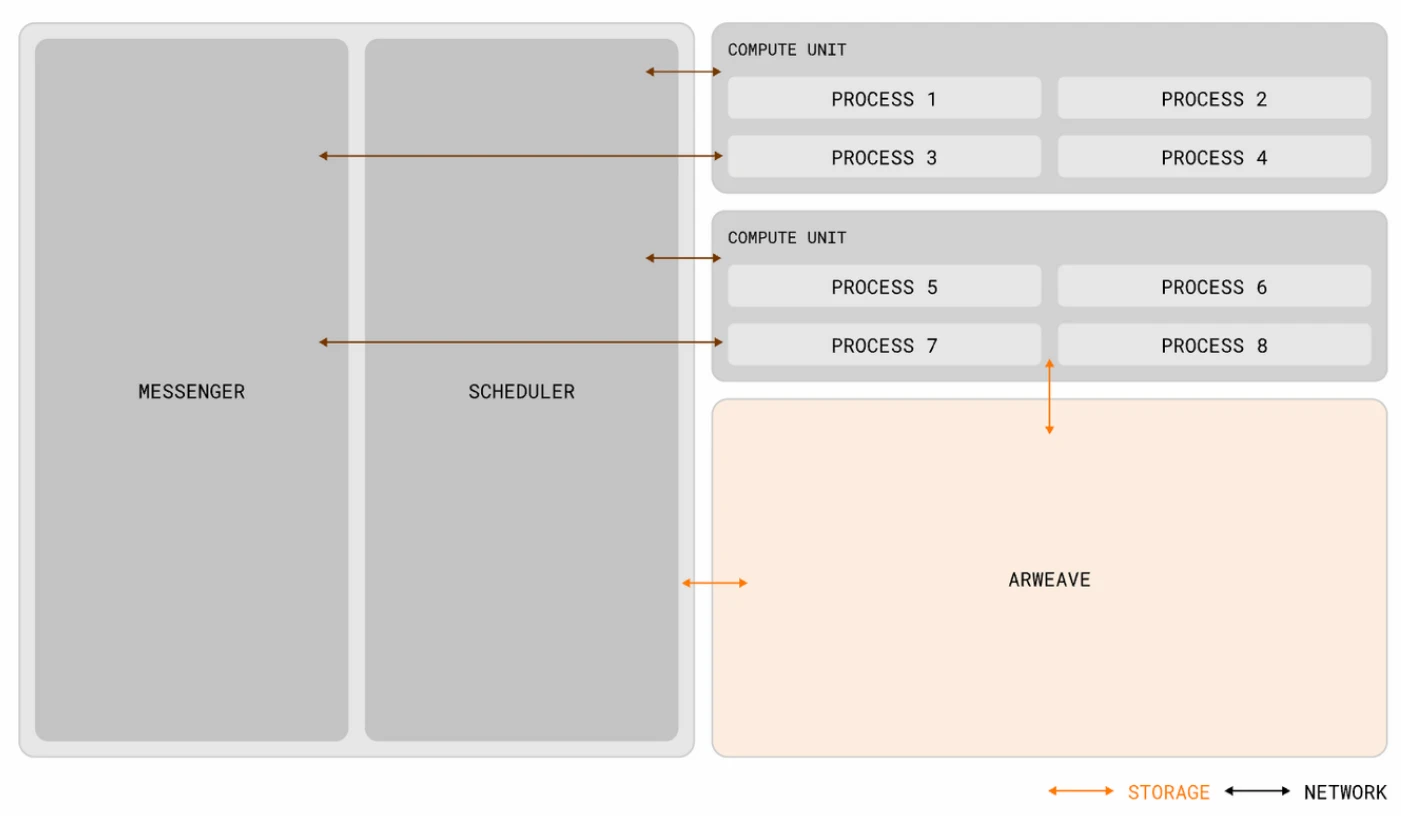
AO achieves verifiable unlimited computing power. The technical points mainly include the following aspects:
(1) Storage-based consensus paradigm (SCP): AO computers reach consensus by holographically storing message logs in Arweave. Arweave is used as a persistent and immutable log book to store all message logs, ensuring that the interaction log is permanently available, allowing any network participant to calculate the state.
(2) Only consensus on data order and storage is required, not on state: Blockchains such as Bitcoin and Ethereum use traditional consensus mechanisms, which require network participants to agree on the state of the ledger. All nodes need to verify and reach consensus on the current state, which results in a waste of computing resources and limits the speed and scalability of the network. AO does not need to reach consensus on the state, but only needs to reach consensus on the order and storage of the interaction log in Arweave. That is, the state of AO is holographically implied in the message log hosted by Arweave. Although there is no consensus on the state, in principle everyone can calculate the state through the data stored in Arweave. If the user wants to obtain the state, he can request the computing unit to complete the calculation and provide proof.
(3) Functional separation of AR and AO: Combined with the above analysis, AR and AO each have their own responsibilities. AO does not solve the verification problem, but is only responsible for completing the message transmission, sorting and state calculation, and mainly deals with calculation problems; Arweave is responsible for dealing with security and verifiability issues, reaching consensus on data order, and ensuring permanent and immutable decentralized storage. AO completes storage based on the interaction log on Arweave, but cannot modify the consensus of Arweave.
(4) Parallel computing architecture based on message passing: The two basic methods for implementing parallel computing are shared memory and message passing. AO adopts a message passing architecture, which is in contrast to the shared memory method used by parallel blockchains such as Solana and Sei. In the shared memory method, when one user accesses and modifies certain data, other users cannot modify it, that is, they need to wait for each other in the process of lock competition until the user unlocks the data before others can access it. Therefore, the scalability of this method has a certain upper limit. AO only needs to send interactive information during interaction, and there is no need to wait for lock competition, which achieves horizontal expansion, which makes its parallel scalability reach any scale.
(5) Modular architecture of AO: The modularity of AO is reflected in the separation of CU, SU, and MU. Users can freely choose the appropriate sequencer, message relay, computing unit, and even the system-level virtual machine can be replaced at will, thereby supporting the introduction of processes in various smart contract systems into AO. CU, SU, and MU can achieve horizontal expansion, ensuring that computing power increases with demand.
Based on the above analysis, the key processes in the AO network include: the interactive information in the AO network is passed to the SU after the signature is verified by the MU, and then uploaded to Arweave after being sorted by the SU. A consensus is reached on the order and stored on Arweave. When the user needs to obtain the status, the message will be passed to the SU through the MU. The SU selects the appropriate CU and delivers the message to the CU. The CU completes the status calculation through the data on Arweave and returns the output to the user through the MU.
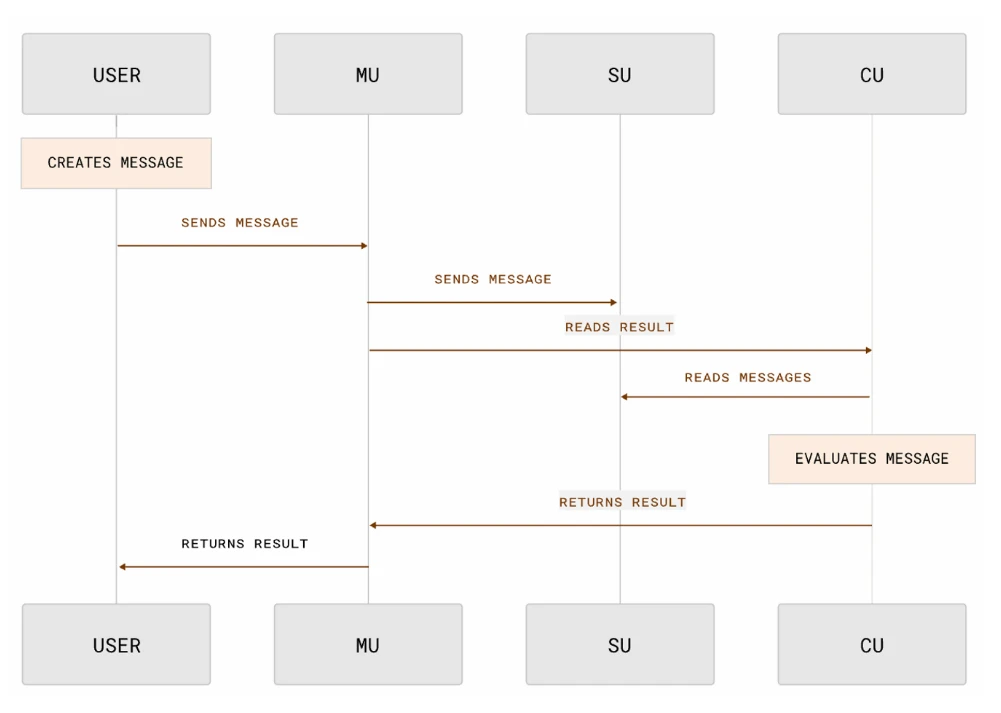
1.2 Does AO’s technology have a moat?
To explore this issue, we compare AO with two similar projects: high-performance public chains with parallelism (such as parallel EVM, Solana, etc.) and decentralized computing protocols (Akash).
Comparison between parallel high-performance public chains and AO:
The main difference lies in the difference in the basic architecture of parallel computing. Here we use Ethereum as a benchmark object to better illustrate the differences of AO. The traditional EVM represented by Ethereum processes transactions sequentially, and only one transaction can modify the state at a time. The entire system presents a unilinear forward mode.
Parallel public chains can generally complete parallel processing of non-conflicting or non-overlapping transactions (conflicting transactions: generally refers to multiple transactions trying to access and modify the same data or state at the same time. This conflict usually leads to data inconsistency). For example, Sealevel allows Solana to process thousands of smart contracts at the same time. Each transaction describes the state it will read or write. The system completes the parallel execution of these non-overlapping and non-conflicting transactions by identifying non-overlapping transactions. Parallel EVM is similar, processing non-conflicting transactions in parallel. Taking Monad as an example, its core process includes three steps: (1) Optimistic execution, that is, optimistically assuming that all transactions are non-conflicting and executing them in parallel at the same time, but this may lead to errors. By tracking input and output comparisons, transactions will be re-executed where there are inconsistent data; (2) Scheduling and dependency. To reduce unnecessary repeated execution, Monad will predict the dependencies between transactions through a static code analyzer, that is, pre-identify possible conflicts between some transactions to optimize execution; (3) State merging. After transactions are executed in parallel, the state updated by each transaction needs to be merged to ensure the state consistency of the entire block.
Although the system efficiency has been improved, the parallel public chain has a very obvious expansion bottleneck: only non-conflicting transactions can be processed in parallel. If it involves accessing and modifying the same state, there is still the problem of lock competition. The difference between AO and the parallel public chain is that: (1) it uses a parallel computing architecture that uses message passing instead of shared memory; (2) it only reaches a consensus on the order of stored data, and does not need to reach a consensus on the state. This makes AO have stronger parallel scalability. The scheduling unit, messenger unit, and computing unit can all be horizontally expanded infinitely, ensuring the infinite expansion of computing power.
Comparison between decentralized computing market and AO:
The network represented by Akash provides a decentralized computing market for container hosting services, but sacrifices the ability to create trustless services, that is, its computing results cannot be verified and reproducible, and therefore loses the ability of smart contracts. In contrast, AOs computing is verifiable computing. Thanks to its holographic state storage mechanism, AO can even maintain the properties of traditional smart contracts. AO ensures that the interaction log is written to Arweave and has persistent availability. The state can be calculated by any participant, and everyone can reproduce the computing process and verify the correctness of other calculators. Measures to ensure verifiability and trustless services can be summarized as follows: (1) All interaction logs are holographically stored on Arweave, making the computing process reproducible; (2) The computing unit needs to provide a cryptographically signed statement about the computing results; (3) The computing unit needs to be pledged, and will face penalties when the computing results are wrong.
To sum up, the architecture combining AO and AR not only ensures unlimited expansion of computing power, but also verifiability and minimal trust in computing. Compared with existing similar projects, it has certain differences and moats.
1.3 AO Ecosystem is thriving
The AO ecosystem is still in its very early stages, but it is booming. According to AOlink’s overall data, the number of messages processed by the AO network has exceeded 116M, and the number of daily users has reached more than 5K at its peak, but has recently fallen back to around 1.5K. The number of holders of the AO network’s test token ($AOCRED, which is used to distribute to builders of the AO network) has also exceeded 4,100.

Within three months after the release of the AO testnet, the infrastructure and financial systems were initially established in the AO network, including cross-chain bridges, oracles, wallets, AMMs, stablecoin protocols, etc. At the same time, applications such as games, social networking, Memecoin, and AI are also being established.
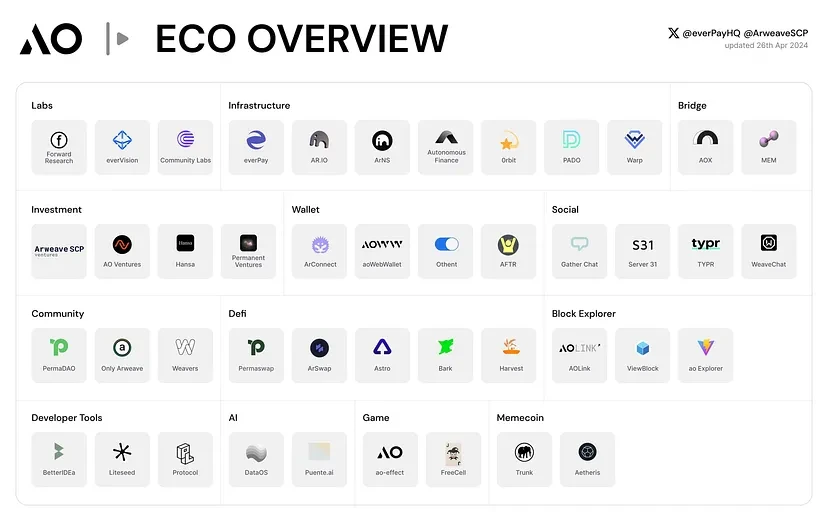
(A panoramic view of the AO ecosystem as of 2024/4/26, source: @everPayHQ @ArweaveSCP)
Key agreements include:
AOX: The first cross-chain bridge in the AO ecosystem, providing cross-chain asset services for the AO network based on MPC technology. It is currently in the Beta stage and only supports the cross-chain of $AR between Arweave and AO networks, which corresponds to Wrapped AR in AO. Incentive tasks are currently being launched, and users can earn $TAOX test tokens by completing tasks such as cross-chain operations, which may correspond to official token airdrops in the future.
0 rbit: The oracle of the AO network, which supports bringing any data to the AO process through a valid URL. Users send messages to 0 rbit to request data, and the 0 rbit node will obtain the data and transmit it to the users process.
Arconnect, aoWebWallet: wallet infrastructure for the AO network.
Astro: The stablecoin protocol of the AO network has been launched on the test network in April. Currently, you can receive the test token tAR and mint the stablecoin USDA through tAR.
Permaswap, ArSwap, Bark: DEX in the AO network. Permaswap has just launched AO recently and currently supports the exchange between Wrapped AR and AOCRED; ArSwap and Bark were launched earlier and support more types of assets. In addition to AOCRED and Wrapped AR, they also support other projects or meme tokens in the ecosystem.
typr: AO ecosystem’s Twitter, a social application. Its open functions and UI are basically the same as Twitter, including posts, long stories, and chatrooms, but it supports rewards using four types of assets: TRUNK/Wrapped AR/AOCRED/typr test tokens.
Permaverse: AO Network’s game and metaverse distribution platform. The currently released game is dumdum. Players can earn points by stroking their dumdum (a green elephant), which corresponds to potential airdrop rewards. At the same time, a very simple metaverse environment is also built for dumdum.
AO Games: A gaming and metaverse distribution platform that was just launched this week. Product features mentioned on Twitter include: Web2-like gaming experience, ability to integrate on-chain AI, etc.
outcome_gg: The prediction market of AO ecology. The prediction indicators include AO ecology, games, defi, meme, business and technology. After the project is announced, AI autonomous agents may be introduced to carry out prediction competitions by relying on LLM.
TRUNK, Aetheris: memecoin of AO ecosystem.
AOVM: An AI tool for the AO ecosystem. For end users, artificial intelligence can be used as a personal assistant, market data analysis tool, and for developers, it can be used as a smart contract development assistant. The product has not yet been launched.
Overall, the AO ecosystem is still in its early stages and has just entered the foundation-laying stage. Most applications are still in the white paper stage, and there are even only tweets and website pages. No specific product and technical documents are online, and the technical capabilities of the AO network have not yet been released and tested at the application layer. The development of the AO ecosystem will also feed back to Arweaves storage business - if external business expansion is not smooth, then the self-built CPU will release the potential of this hard drive.
2. What is the relationship between AO and AI tracks?
After the launch of AO, Arweave was re-compared with projects in the AI track and the parallel EVM track. In the previous article, we have introduced the difference between AO and parallel EVM. This section will briefly analyze the position of AO in the AI track.
AO itself is designed using the Actor model, which is closely related to AI research. The core idea is that each component of the system can be an independent, autonomous agent, which can be interacted with by sending messages. The Actors and AI Agents in this model are very similar, which makes hosting AI models and building AI applications in the AO ecosystem a very attractive direction. So specifically, how will AO solve the problem of empowering AI?
In a nutshell, AO makes it more feasible to put AI models on the chain, and can realize the calculation of the verifiability of AI models, thereby promoting the integration of AI models into smart contracts and expanding the use of AI in the Crypto world.
First, model on-chain means storing the ML model in a smart contract on the blockchain, and the model can be used by calling the smart contract method. However, this requires: (1) storing the AI model and data on the chain, that is, saving the complete model and required data in thousands of nodes. The storage cost is extremely high, and it is economically unfeasible to store the model, especially the large language model, on the chain; (2) computing resources are limited. At the same time, the blockchain has high latency and low throughput, which will limit the high-performance computing of AI models. To perform AI model calculations on the chain, all nodes need to complete the calculation process at the same time, which is obviously not supported by this single-threaded architecture.
Therefore, currently model calculations are mainly performed off-chain and the results are returned to the chain. A compromise is to use opml/zkml to implement the on-chain proof of reasoning results to improve the verifiability of off-chain calculations.
Compared with traditional blockchains (such as Ethereum), AOs technical advantages are: (1) it can be natively connected to Arweave. AR provides a storage layer, making it possible to store large amounts of data at low cost; (2) it can achieve verifiable and infinitely scalable parallel computing. This enables AO to solve many problems of on-chain models in traditional blockchains, such as the ability to store AI models, making it possible to host large language models. In addition, parallel computing capabilities effectively alleviate the demand for computing resources, and there is no need to repeat model calculations on all nodes, reducing computing redundancy and improving computing efficiency. In addition, all data in Arweave can be used as input for AO calculations, which greatly increases the data that can be used by on-chain models and promotes on-chain agents or AI applications to rely on more reliable data to make decisions.
The first focus of AO ecosystem in AI will be the combination of AI and finance, and AgentFi is proposed. AgentFi refers to the use of AIs reasoning ability to create and adjust complex strategies similar to fund managers. Using AI models to manipulate money is a sensitive matter, especially trustworthiness is particularly important. Compared with the introduction of AgentFi on other chains, AO ecosystem has taken the lead in opening up the verifiability of calculations. The first project launched so far is Autonomous Finance. Autonomous Finance hopes to achieve financial agents including: DCA asset management agent, autonomously balanced index fund agent, autonomous hedge fund agent with customized risk strategy, on-chain prediction agent, high-frequency trading agent, etc. At present, the DCA investment agent product has been launched, and users can set fixed investment asset types, slippage range, liquidity pool, fixed investment time and other parameters. Of course, this does not realize the use of AI wisdom to formulate investment strategies, but more stays at the level of contract automation that does not require off-chain triggering. We also need to track the capabilities of subsequent products to determine whether they are serious products or gimmicks.
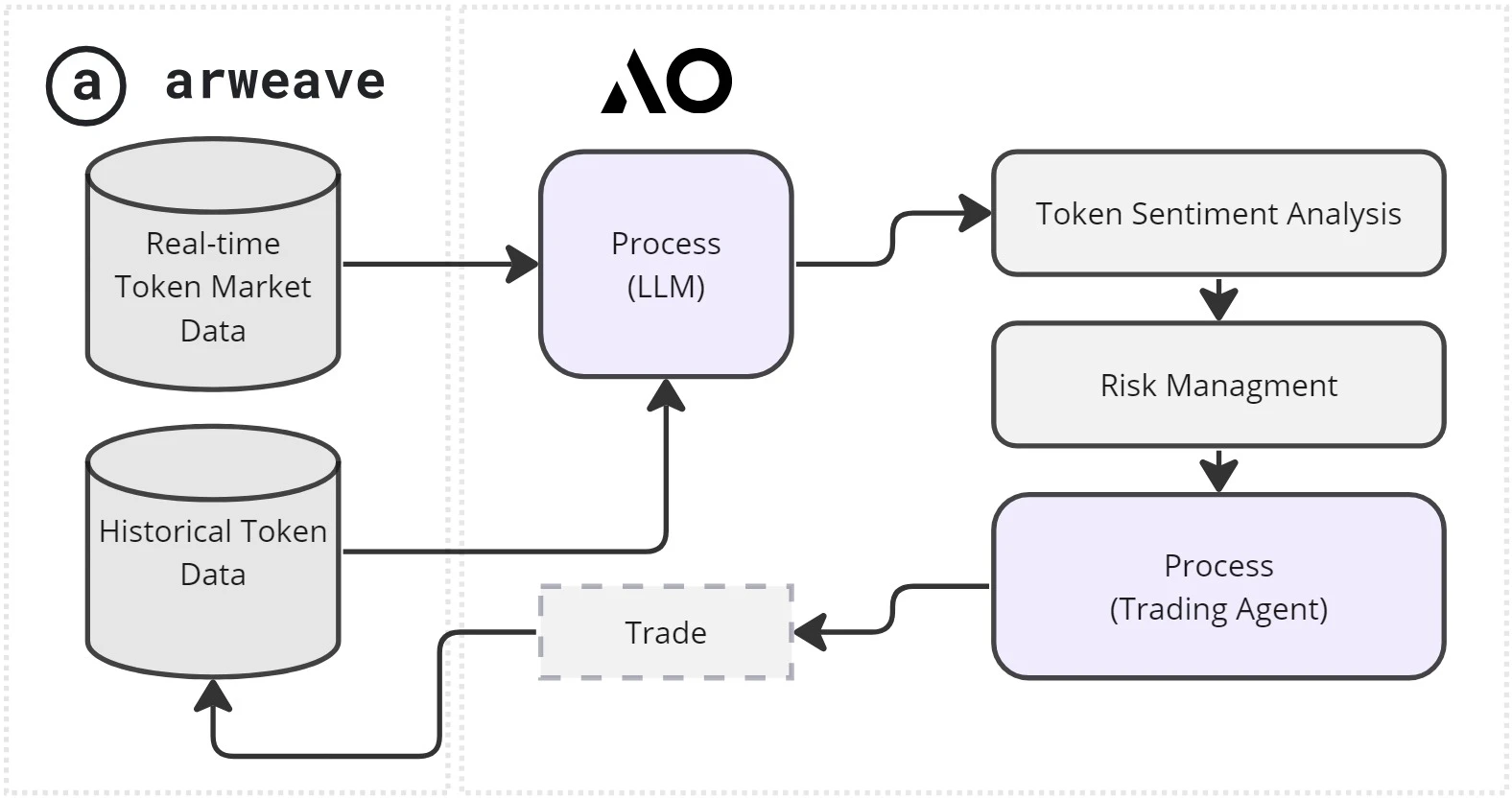
3. Related token economics and chip analysis
On May 30, 2024, AO announced that it will soon complete the issuance of $AO tokens, and the token will be launched on June 13, Beijing time. In addition, the token associated with this project is $AR. Before $AO completes TGE, $AR is still one of the targets of speculation.
The maximum supply of $AR tokens is 66 million. 55 million were initially minted, all of which have now entered the market. The remaining 11 million are used as mining rewards, of which 10,744,796 tokens have been mined. The current mining reward for each block is about 0.75 $AR, which will be halved every year. Arweave mines about 660 blocks per day, so the total number of newly added $ARs in circulation per day is about 500, and the selling pressure generated by mining is very small. The current circulating supply of $AR is 65,744,796, and the unlocking rate has reached 99.61%, which can be regarded as being in full circulation.
In terms of token usage scenarios, $AR is used as a payment medium for users to store data, and as an incentive for miners to produce blocks and store data. Arweave has a storage insurance fund (Storage Endowment) mechanism, that is, the storage fees paid by users will not be fully distributed to miners. Currently, only 16.67% will be distributed to miners, and the rest will automatically enter the storage insurance fund. Therefore, whenever data is uploaded, the Arweave network will move the corresponding number of tokens in circulation to the fund (Endowment) used to pay for the data storage fees accumulated over time. This fund will only be issued when the storage cost of miners is higher than the sum of new mining rewards + transaction fees to ensure that miners are always profitable. However, since the birth of Arweave, no one has extracted a token from the storage insurance fund, which also makes the storage insurance fund regarded as a burning mechanism for $AR. When the growth rate of the storage insurance fund is greater than the newly added $AR, $AR can be regarded as entering a deflationary state.
From the price trend, after the release of AO, the price of $AR rose rapidly, increasing by 4 times in one month. In the recent short-term bear market, the price of AR rose against the trend and is close to a new high. At present, the chip concentration area is still concentrated around $10, and the other chip concentration areas are mainly around $20-$40. $AR has tested the area around $47 twice, and the current price has come to this level again.

In terms of valuation analysis, there are currently no projects in the exact same category as Arweave and AO. Projects with similar businesses include parallel EVM, high-performance public chain decentralized storage, and decentralized computing protocols. Arweave is roughly equivalent to high-performance public chains and Filecoin in terms of market capitalization, and higher than Akash and Sei, but in terms of FDV, public chains and storage projects are much higher than Arweave. Therefore, considering that the AO ecosystem is still in its very early stages and the mainnet has not yet been launched, $AR’s current market capitalization is not significantly undervalued, but the almost fully circulated state reduces the dilution effect brought about by token issuance, and the subsequent resistance to rising prices may be relatively small.
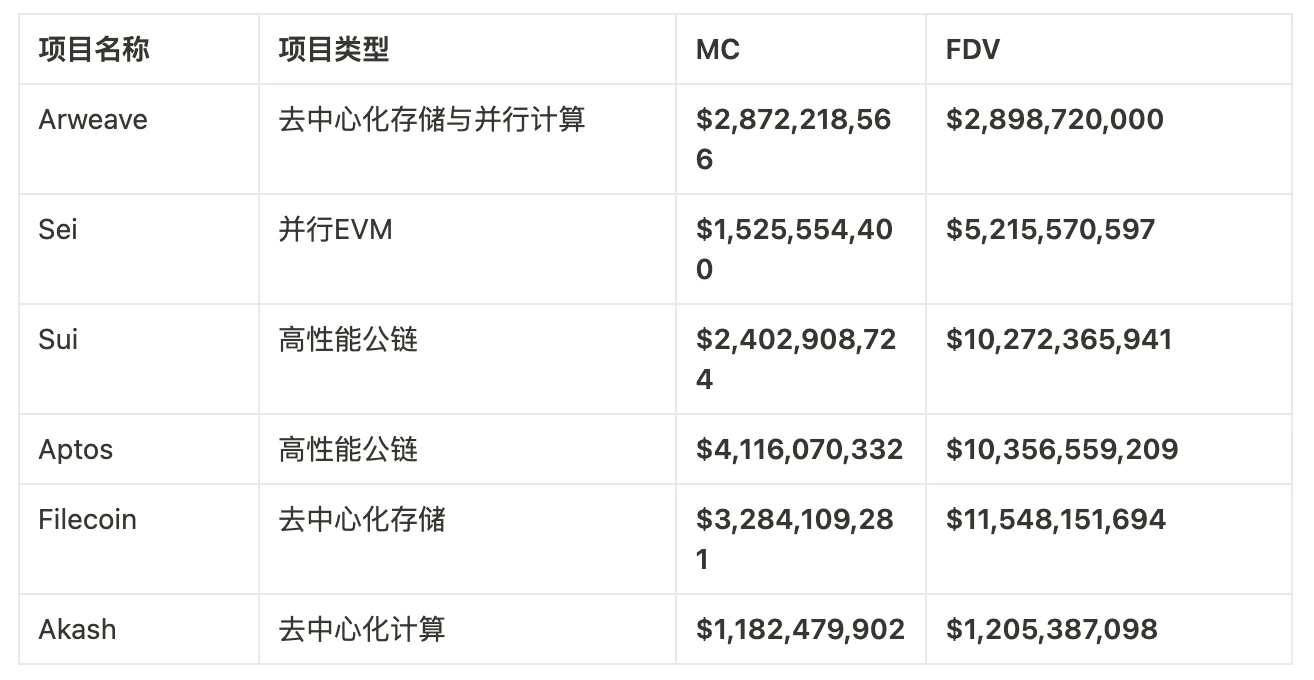
Closely related to the token is the future issuance of the AO token. According to official news, $AO will be launched with 100% fairness, without pre-mining, pre-sale and priority acquisition. The total token supply is 21M, and it will be halved every four years. What is important is the way to obtain the token: (1) bridge assets to AO (2) hold $AR (3) participate in the construction of the AO ecosystem. At present, the specific token model of AO has not been announced. According to the answer of outprog, one of the proposers of AO, in X Space, AO tokens and AR tokens will have their own functions. AR tokens mainly focus on the storage function and consensus maintenance of Arweave, while AO tokens focus on solving the communication problem between computing and applications, that is, AO and AR maintain the computing and storage functions of the network respectively.
After the announcement of the $AO token, $ARs maximum short-term increase exceeded 18%. On the one hand, $AR is currently the only target of this event, and on the other hand, it may be related to the rule that $AR can be obtained by holding $AR. The two rules of bridging assets to AO (currently $AR is basically the only asset that can cross-chain to the AO network) and holding $AR are actually digesting the selling pressure on $AR caused by this event. However, it should be noted that the $AR token currently carries the markets dual valuation of computing and storage. When $AO is about to be released, $AR will also need to be revalued, which may dilute part of $ARs market value.
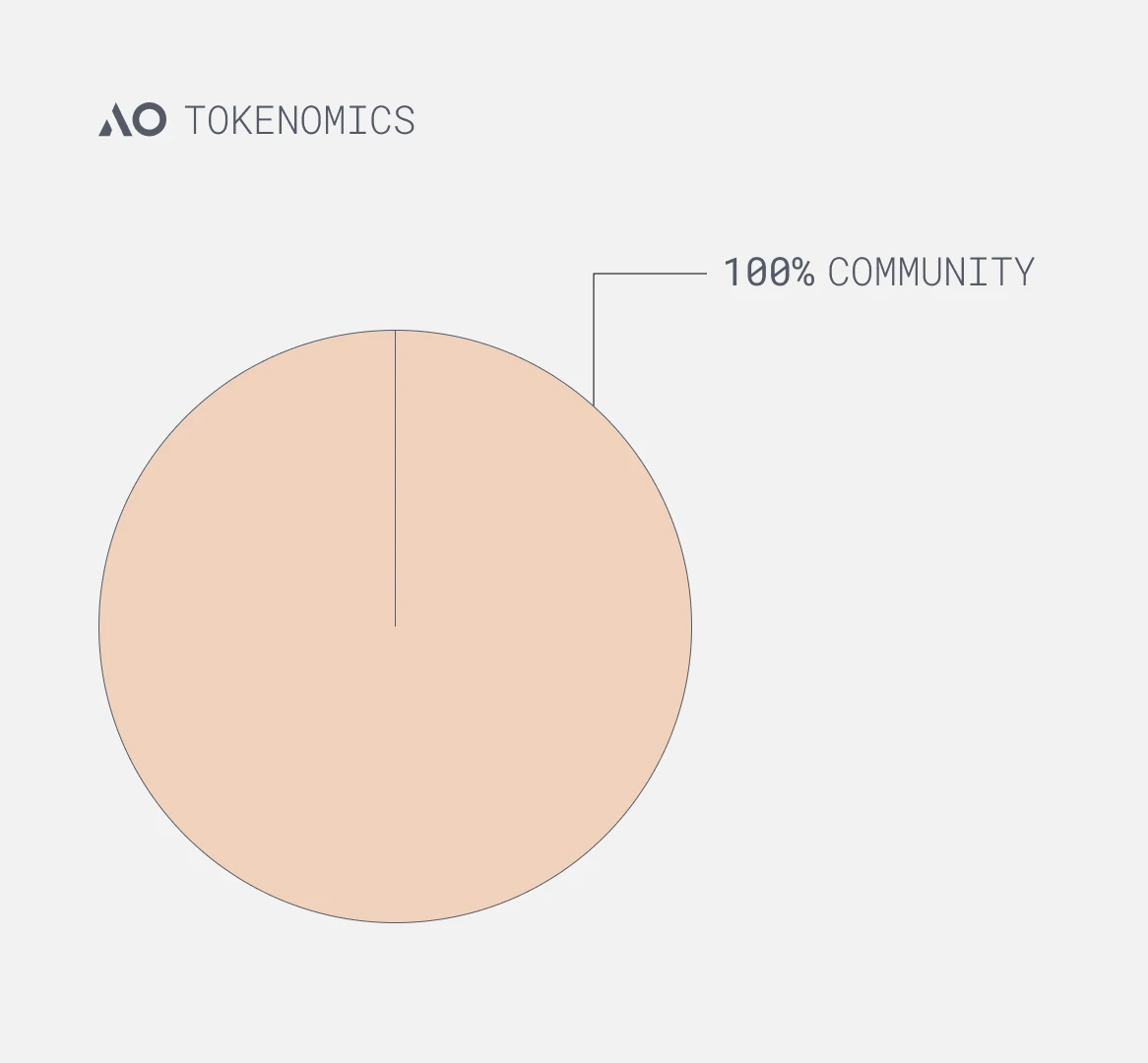
4. Summary
Although the market always says speculate on new things, not old things, because old narratives often attract new market attention, some old projects are bringing new surprises with technological innovation, and compared with new coin projects, the tokens of these old projects have basically entered the full circulation stage, with less unlocking and selling, and have fully bottomed out in the bear market, so these old projects may bring greater room for growth, and Arweave is a typical example of such a project. The combination of AO and AR has verifiable infinite parallel computing capabilities, which provides a technical moat for Arweave and injects new vitality and narratives.
From the perspective of ecological development, AO is still in the testnet stage, and ecological construction is in the very early stages. AOs real computing power has not been actually tested and exerted. We expect that the AO ecosystem should give birth to some projects that can exert its unique technical capabilities such as storage, verifiable computing, and large-scale parallel computing, such as decentralized social applications (which can ensure the permanent storage and call of social data), AI infrastructure and applications, etc. From the perspective of market attention, although the price of AR has been steadily rising in the past period of time, the discussion among ordinary users is not high, and the AO testnet has not become a big hair to attract market attention. Due to its relatively complex technical details, it is difficult for ordinary users to recognize the difference between AO and high-performance public chains and decentralized protocols, and how AO can cut into the AI track, so they have not fully realized AOs growth potential. AO is still in the very early stages of protocol development, and there is a lot of room for subsequent development. However, if the ecological development is not as expected, especially after the mainnet is launched, the performance and user experience are not up to expectations, and there are no sufficiently technically capable and out-of-the-box AI projects, the valuation of $AO will be greatly discounted.
about Us
Metrics Ventures is a data and research driven crypto asset secondary market liquidity fund led by an experienced team of crypto professionals. The team has expertise in primary market incubation and secondary market trading, and plays an active role in industry development through in-depth on-chain/off-chain data analysis. MVC works with senior influencers in the crypto community to provide long-term empowerment support for projects, such as media and KOL resources, ecological collaboration resources, project strategies, economic model consulting capabilities, etc.
Everyone is welcome to DM to share and discuss insights and ideas about the market and investment of crypto assets.
Our research content will be published simultaneously on Twitter and Notion, welcome to follow:
Twitter: https://twitter.com/MetricsVentures
Notion: https://www.notion.so/metricsventures/Metrics-Ventures-475803b4407946b1ae6e0eeaa8708fa2?pvs=4
Hiring! We are looking for traders with good salary and flexible working location.
If you: have bought sol below 40/ ordi below 25/ inj below 14/ rndr below 3.2/ tia below 10 and meet any two of the above, please contact us at admin@metrics.ventures, ops@metrics.ventures

